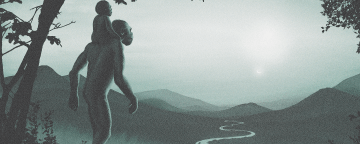Katarina Zimmer in The Scientist:
 It’s not unusual for geochronologist Rainer Grün to bring human bones back with him when he returns home to Australia from excursions in Europe or Asia. Jawbones from extinct hominins in Indonesia, Neanderthal teeth from Israel, and ancient human finger bones unearthed in Saudi Arabia have all at one point spent time in his lab at Australian National University before being returned home. Grün specializes in developing methods to discern the age of such specimens. In 2016, he carried with him a particularly precious piece of cargo: a tiny sliver of fossilized bone covered in bubble wrap inside a box.
It’s not unusual for geochronologist Rainer Grün to bring human bones back with him when he returns home to Australia from excursions in Europe or Asia. Jawbones from extinct hominins in Indonesia, Neanderthal teeth from Israel, and ancient human finger bones unearthed in Saudi Arabia have all at one point spent time in his lab at Australian National University before being returned home. Grün specializes in developing methods to discern the age of such specimens. In 2016, he carried with him a particularly precious piece of cargo: a tiny sliver of fossilized bone covered in bubble wrap inside a box.
The bone fragment had come from a skull—still stored at the Natural History Museum in London—with a heavy brow ridge and a large face. It looked so primitive that the miner who had discovered it in 1921 at a lead mine in the Zambian town of Kabwe, then in the British territory of Rhodesia, first thought it had belonged to a gorilla. But later that year, museum paleontologist Arthur Smith Woodward noticed what he interpreted as typically human features, such as the skull’s thin and relatively large braincase, that motivated him to designate the specimen as its own hominin species.
In the 1980s, however, museum paleoanthropologist Chris Stringer took another look at the skull and classified it as belonging to the species Homo heidelbergensis, an ancient hominin thought to be a human ancestor. Based on its primitiveness, Stringer says, most researchers guessed it was an early individual who lived around half a million years ago, some 200,000 years before the earliest Homo sapiens were starting to emerge. But nobody knew exactly how old the skull was. For decades, no dating method existed that could identify the fossil’s age without the destructive process of grinding up bits of bone for analysis. But Grün was determined to find a solution.
More here.
